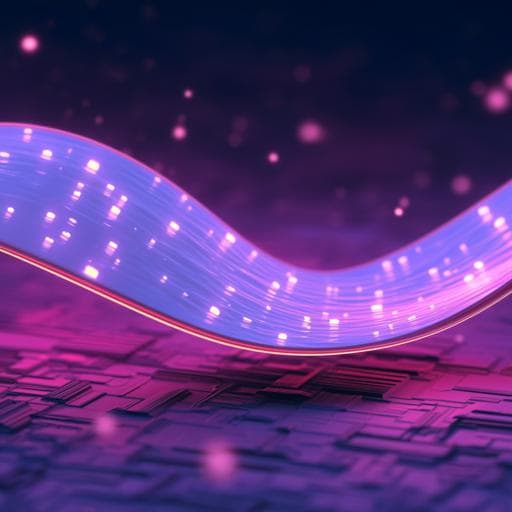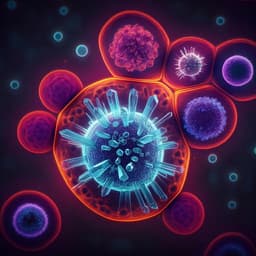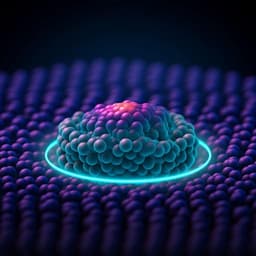
Engineering and Technology
Large-area transfer of two-dimensional materials free of cracks, contamination and wrinkles via controllable conformal contact
Y. Zhao, Y. Song, et al.
Discover a revolutionary technique that enables the transfer of two-dimensional materials onto any surface without the hassles of cracks, contamination, or wrinkles. Achieving ultraclean surfaces and incredibly high carrier mobilities, this cutting-edge research was conducted by a team of experts including Yixuan Zhao, Yuqing Song, Zhaoning Hu, and many more.
~3 min • Beginner • English
Introduction
The study addresses the critical challenge of transferring large-area CVD-grown graphene (and other 2D materials) onto arbitrary substrates without introducing cracks, wrinkles, or interfacial contamination. Conventional PMMA-assisted transfer often leads to non-conformal adhesion, free-standing regions, damage during removal of support films, and residue contamination, which degrade electronic performance, especially carrier mobility. The research question is how to engineer the transfer process and interfacial adhesion to ensure conformal contact over large areas, thereby achieving crack-free, wrinkle-free, and contamination-free graphene transfer compatible with industrial-scale processing and diverse substrates (rigid SiO2/Si and flexible PET). The authors propose structurally modifying supporting films to controllably deform upon heating, promoting fine conformity and enabling clean mechanical delamination of supports.
Literature Review
Prior work achieved scalable growth of graphene and other 2D materials via CVD on limited substrates, but reliable post-growth transfer remains problematic. Transfer-related cracks, wrinkles, and residues have been widely reported, and their impact on homogeneity and mobility is well documented (e.g., refs. 4–16). Supporting foils and adhesives have been introduced to improve lamination, yet non-conformal adherence persists, leading to tearing during support removal. Polymer-free transfers can reduce contamination but struggle with large-area films. Approaches like paraffin-enabled and rosin-enabled transfers improve cleanliness but still leave residues and/or defects at scale. Conformal contact has been recognized as important, but achieving fine conformity over wafer-scale areas with high mobility comparable to exfoliated graphene remains elusive. This work builds on these insights by engineering support films (PMMA modified with oxhydryl-containing volatile molecules or PPC/PMMA bilayers) to induce heat-driven deformation and conformity, combined with bubbling-based delamination and solvent-free support removal.
Methodology
- Supporting film design and mechanism: OVM-modified PMMA: Oxhydryl group-containing volatile molecules (cedrol, alpha-terpineol, linalool, borneol) are embedded in PMMA via hydrogen bonding to carbonyl oxygen and steric hindrance. Upon heating, OVMs evaporate, PMMA chains restack, and the supporting film shrinks/deforms (~30 nm height decrease), pushing graphene into conformal contact with SiO2/Si. PPC/PMMA bilayer: Layer-by-layer blade coating forms partially immiscible PPC/PMMA; heating above PPC Tg induces blending, viscosity increase, smoothing of graphene topography, overall film height reduction (~27 nm), and conformal contact to PET. Rigid thermal release tape (TRT) is used for handling; heating releases TRT to allow final conformity. Silicone tape peels off the polymer stack to leave clean graphene.
- Growth: Single-crystal Cu(111) on sapphire via RF sputtering (500 nm) and annealing at 1020 °C (Ar/H2). Graphene grown by APCVD: Cu(111) at 1020 °C with Ar/H2, CH4 (0.1% in Ar), 2 h full coverage; also on Cu9Ni10(111). Large-area graphene on 50 µm Cu foil via LPCVD at 1020 °C with H2 anneal then 1 sccm CH4 for 1 h.
- Transfer to SiO2/Si (4-inch wafers): Spin-coat 10 wt% OVMs in n-heptane, then PMMA (950k A4). Laminate TRT. Electrochemical bubbling delamination from Cu with custom equipment; rinse and dry at 40 °C. Laminate to SiO2/Si at 100 °C. Heat at 120 °C to induce film deformation and conformity. Mechanically peel off supporting films/TRT to yield ultraclean graphene; no organic solvent bath is used for support removal.
- Transfer to PET (A4): Blade coat PPC (Mw 30k, 0.05 g/mL) then PMMA; laminate TRT; bubbling delamination; dry; laminate to PET at RT; heat at 140 °C for 1 min to release TRT; laminate silicone tape onto support films and peel off to leave clean graphene on PET.
- Characterization: Macro- and micro-intactness quantified by photography/scanner images and OM at 5x/50x, with pixel counting and statistics. Surface roughness and cleanliness by AFM, white light interferometry (entire 4-inch wafer), XPS, and ToF-SIMS using deuterium-labeled PMMA (2H-PMMA) for residue mapping. Raman (532/633 nm) for D, G, 2D bands; UV-Vis for transmittance; four-point probe for sheet resistance. Conformity assessed by AFM edge step height histograms.
- Electrical devices: For intrinsic quality, hBN/graphene/hBN stacks fabricated via PPC/PDMS pickup and one-dimensional Cr/Au contacts; Hall bars patterned via EBL and RIE; measured via lock-in at 300 K and 4 K, including Shubnikov–de Haas. Wafer-scale Hall bars on SiO2/Si fabricated by maskless lithography for mobility mapping.
- Modeling: Molecular dynamics (LAMMPS) to compute adhesion stress vs separation Δ for graphene on SiO2, using LJ interaction (ε=4.148 meV, σ=2.79 Å) and AIREBO for C–C; coarse-grained SiO2 substrates with geometry from AFM. For PET, van der Waals approximated by scaling ε (α=0.5–3).
- Extensions: Layer-by-layer transfer to fabricate graphene/MoS2 heterostructures; solvent-free transfer onto solvent-sensitive Nafion foils; transfer of Cr/Au electrodes using Cu sacrificial layer and OVMs-modified films.
Key Findings
- Conformal, crack-free large-area transfer: Heat-induced deformation of OVM-modified PMMA and PPC/PMMA achieves fine conformity to SiO2/Si and PET, respectively. Final intactness (macro × micro) ~99% on both 4-inch SiO2/Si wafers and A4 PET films. Reported statistics: 4-inch SiO2/Si macro-intactness ≈99.6% ± 0.3%, micro-intactness ≈99.3% ± 0.5%; A4 PET macro-intactness ≈99.8% ± 0.1%, micro-intactness ≈99.3% ± 0.6%.
- Contamination-free surfaces: Mechanical peeling of support films (no acetone bath) yields ultraclean graphene with AFM roughness Rr ≈0.183 nm (vs 0.651 nm for conventional PMMA). Wafer-scale white light interferometry roughness 0.25 ± 0.03 nm, comparable to bare SiO2/Si. ToF-SIMS with 2H-PMMA shows ~4 orders of magnitude reduction in PMMA residue across 4-inch wafers; XPS shows absence of residue-related C–O and O–C=O peaks.
- Wrinkle suppression: Conformal state avoids formation of new wrinkles; 4-inch wrinkle-free single crystals obtained.
- Conformity metrics: AFM edge step height reduced from ~1.56 nm (conventional) to near a single-peak distribution with smaller height differences, akin to exfoliated graphene, indicating elimination of air gaps. MD simulations show adhesion stress peaks near Δ≈3.2 Å and decreases sharply with separation; reduced Δ in this method strengthens adhesion, enabling direct delamination of supports.
- Electronic performance: hBN-encapsulated devices show room-temperature carrier mobilities 70,000–120,000 cm2 V−1 s−1 and 800,000–1,420,000 cm2 V−1 s−1 at 4 K, surpassing previous CVD graphene reports and comparable to top exfoliated/suspended devices. Clear Shubnikov–de Haas oscillations with full breaking of fourfold degeneracy at low T. On SiO2/Si wafer devices (18 Hall bars across 4-inch wafer), average room-temperature mobility ≈8,800 cm2 V−1 s−1.
- Flexible electronics metrics: After PEDOT:PSS coating, sheet resistance uniformly reduced to 87 ± 13 Ω/sq with optical transmittance 92.3% (overall graphene transmittance ~97.6%).
- Generality: Successful solvent-free transfer onto Nafion foils (verified by OM/Raman) and fabrication of clean graphene/MoS2 heterostructures with Raman shifts indicating strong interlayer coupling. Transfer of patterned Cr/Au electrodes (5/50 nm) onto PET and SiO2/Si without chemical release etchants.
- Process/throughput: Customized bubbling-delamination equipment enables controlled, faster delamination, recyclable metal substrates, and avoids etchant waste compared with conventional methods.
Discussion
By engineering supporting films to undergo controlled thermal deformation, the process achieves conformal contact between graphene and target substrates, which eliminates free-standing regions and air-gap-induced p-doping, prevents crack and wrinkle formation, and substantially strengthens graphene–substrate adhesion. This enhanced adhesion allows direct mechanical delamination of supports, avoiding solvent-based PMMA removal and drastically reducing residues, as confirmed by wafer-scale ToF-SIMS and XPS. The conformal, ultraclean interfaces translate to outstanding electronic performance: mobilities in hBN-encapsulated devices reach up to 1.42×10^6 cm2 V−1 s−1 at 4 K, with clear quantum oscillations, and improved wafer-scale device mobility on SiO2/Si. The method scales to 4-inch wafers and A4 sheets, reduces processing time, and is compatible with flexible substrates, achieving low sheet resistance at high transparency after PEDOT:PSS doping. The approach generalizes to other 2D materials and device components (e.g., MoS2 heterostructures, Nafion substrates, and metal electrode transfer), highlighting its relevance for van der Waals integration and flexible optoelectronics. MD simulations support the experimental observations by linking reduced separation distance to increased adhesion through van der Waals interactions, explaining why conformity enables clean support peeling.
Conclusion
The work presents a scalable, solvent-free transfer strategy that uses heat-deformable, OVM-modified PMMA or PPC/PMMA supports to establish conformal contact, yielding large-area graphene transfers that are crack-free, wrinkle-free, and ultraclean. The resulting graphene exhibits exceptional electronic quality, including million-level low-temperature mobilities after hBN encapsulation, and uniform, low sheet resistance on flexible substrates when combined with PEDOT:PSS. The method is versatile for assembling van der Waals heterostructures, transferring onto solvent-sensitive substrates, and relocating metal electrodes, while enabling metal substrate recycling and minimizing chemical waste. Future research could optimize interfacial design to mitigate residual tensile strain introduced by conformity, refine support chemistries and processing windows for broader material/substrate compatibility, develop more accurate interaction models for polymeric substrates, and integrate the process into industrial batch production lines for 2D material-based electronics and optoelectronics.
Limitations
- Conformal contact, while eliminating compressive strain and air gaps, can introduce tensile strain relative to free-standing graphene, which may require further interfacial engineering to optimize device performance.
- For graphene on PET, molecular simulations used an approximate scaling of van der Waals interaction due to the lack of reliable potentials, limiting quantitative accuracy of adhesion modeling.
- The rigid thermal release tape can hinder conformity before heat release; process control of heating and release is required for optimal results.
- Certain OVM formulations have processing constraints (e.g., borneol mass fraction in n-heptane should be ≤10 wt% to avoid precipitation), which may limit parameter windows and require fine-tuning for different materials or scales.
Related Publications
Explore these studies to deepen your understanding of the subject.







